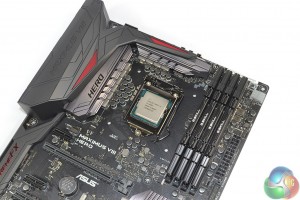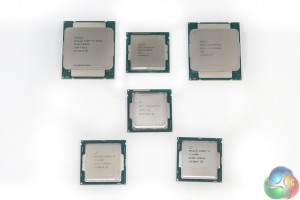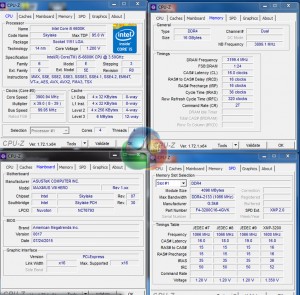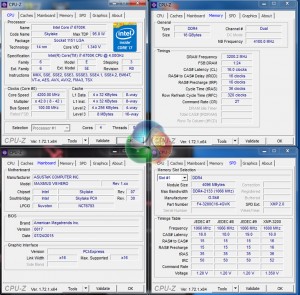Skylake is the ‘tock' phase for Intel's 14nm manufacturing process. What that means is that Skylake introduces a new architecture based on a manufacturing process node introduced by its predecessor (Broadwell).
But Broadwell was very much a mobile-first chip design, so Skylake's most potent competitors are likely to be the venerable Devil's Canyon chips and their Haswell architecture, notably the i7-4790K.
We will be outlining the Skylake Core i7-6700K and Core i5-6600K CPUs' performance while using an Asus Maximus VIII Hero Z170 motherboard. We expect the Skylake 6700K to show slight performance improvements over the Devil's Canyon 4790K thanks to the former's newer architecture. It will be interesting to see how the i7-6700K competes with the closely-priced Haswell-E 5820K and its six hyper-threading cores.
A 16GB (4x4GB) kit of G.Skill's new Ripjaws V DDR4 memory serves our test system. The kit's rated frequency of 3200MHz with CL16 timings should ensure that memory-induced bottlenecks are removed.
Today's comparison processors come in the form of a Devil's Canyon i7-4790K, Haswell-E i7-5820K, and Haswell-E 5960X. These form some of the best and most popular CPUs in their respective pricing ranges and product hierarchies.
We would have liked to include comparison data from Intel's recently-released 14nm Broadwell Core i7-5775C CPU, as well as some older Ivy Bridge Core i5 and Sandy Bridge Core i7 models. Unfortunately the compressed time scale that these product launches take place in meant that we simply had not enough time to test those additional comparison models.
As such, we will be producing a follow-up article which focuses on a few points, such as gaming, and includes comparisons from a broader range of CPUs. Check back soon for that piece.
CPU-Z has trouble tracking the CPU's voltage, so instead we carefully used Asus' AI Suite 3 software to gather recordings. AI Suite 3 reported stock-clocked voltage levels of 1.20-1.25V depending on whether the CPU was idling or under heavy load.
Applying XMP settings with Asus' motherboard gives the option for multi-core turbo (MCT) to be enabled. MCT locks all of the CPU cores at the maximum turbo frequency at all times. This provides greater performance at the expense of increased power consumption and load temperatures. We tested using MCT settings for all of the CPUs.
CPU Test System Common Components:
- Graphics Card: Nvidia GeForce GTX 980Ti.
- CPU Cooler: Corsair H100i.
- Power Supply: Seasonic Platinum 1000W.
- Operating System: Windows 7 Professional with SP1 64-bit (and latest updates).
Corsair's H100i and the Seasonic 1000W Platinum provide ample cooling and power to really push the CPU overclocks. Nvidia's GTX 980Ti is, excluding the Titan X, the fastest gaming GPU on the planet, making it ideal to alleviate GPU-induced bottlenecks.
Polls on our main site and discussion on the Facebook page have shown that Windows 8 (and 8.1) has been incredibly unpopular amongst our readers. That left us with the decision between Windows 7 and Windows 10 for our test system. With the CPU benchmarking being conducted so close to Windows 10's launch, we decided that playing-it-safe with the tried-and-tested Windows 7 OS was the best way of ensuring consistent, accurate, bug-free test results.
Skylake 6600K & 6700K System:
- 6600K CPU: Intel Core i5-6600K ‘Skylake' (Retail) 4 cores, 4 threads (3.9GHz stock MCT & 4.5GHz @ 1.35V overclocked).
- 6700K CPU: Intel Core i7-6700K ‘Skylake' (Retail) 4 cores, 8 threads (4.2GHz stock MCT & 4.7GHz @ 1.40V overclocked).
- Motherboard: Asus Maximus VIII Hero (LGA 1151, Z170).
- Memory: 16GB (4x4GB) G.Skill Ripjaws V 3200MHz 16-16-16-36 DDR4 @ 1.35V.
- System Drive: Crucial BX100 250GB.
Haswell-E 5820K System:
- CPU: Intel Core i7 5820K ‘Haswell-E' (Retail) 6 cores, 12 threads (3.6GHz stock MCT & 4.5GHz @ 1.275V overclocked).
- Motherboard: Asus X99-Deluxe (LGA 2011-v3, X99).
- Memory: 16GB (4x4GB) Corsair Vengeance LPX 3200MHz 16-18-18-36 DDR4 @ 1.35V.
- System Drive: Samsung 840 500GB.
Haswell-E 5960X System:
- CPU: Intel Core i7 5960X ‘Haswell-E' (Engineering Sample) 8 cores, 16 threads (3.5GHz stock MCT & 4.4GHz @ 1.30V overclocked).
- Motherboard: Asus X99 Deluxe (LGA 2011-v3, X99).
- Memory: 16GB (4x4GB) Corsair Vengeance LPX 3200MHz 16-18-18-36 DDR4 @ 1.35V.
- System Drive: Samsung 840 500GB.
Devil's Canyon 4790K System:
- CPU: Intel Core i7 4790K ‘Devil's Canyon' (Engineering Sample) 4 cores, 8 threads (4.4GHz stock MCT & 4.7GHz @ 1.30V overclocked).
- Motherboard: ASRock Z97 OC Formula (LGA 1150, Z97).
- Memory: 16GB (2x8GB) Corsair Vengeance Pro 2400MHz 10-12-12-31 DDR3 @ 1.65V.
- System Drive: SanDisk Extreme II 240GB.
Software:
- Asus Maximus VIII Hero BIOS v0017 (latest).
- GeForce 353.30 VGA drivers.
Tests:
- Super Pi – 32M test (CPU)
- Cinebench R15 – All-core & single-core CPU benchmark (CPU)
- 7-Zip 15.05 beta – Built-in benchmark and manual video archival (CPU)
- HandBrake 0.10.2 – Convert 1.23GB 1080P game recording using the High Profile setting and MP4 container (CPU)
- SiSoft Sandra 2015 SP2b (v2142) – Processor arithmetic, cryptography, memory bandwidth (CPU & Memory)
- 3DMark 1.5.915 – Fire Strike Ultra (System)
- PCMark 8 v2.4.304 – Home – OpenCL accelerated (System)
- Grand Theft Auto V – 1920 x 1080, near-maximum quality (Gaming)
- Middle Earth: Shadow of Mordor – 1920 x 1080, ultra quality (Gaming)
- Metro: Last Light – 1920 x 1080, very high quality (Gaming)
- Tomb Raider – 1920 x 1080, maximum quality, TressFX disabled (Gaming)
 KitGuru KitGuru.net – Tech News | Hardware News | Hardware Reviews | IOS | Mobile | Gaming | Graphics Cards
KitGuru KitGuru.net – Tech News | Hardware News | Hardware Reviews | IOS | Mobile | Gaming | Graphics Cards







Like the review but leaves me wondering what’s point in upgrading
1.4 volts is too much .. 1.35 is at most what I would consider 24×7 safe with folding for years on end.
Great review, love the OC comparison to HW-E, the only site has done this so far.
If you’re folding 24/7, then you are probably right that 1.4V is a bit too much as it likely to hinder your CPU lifespan. But for most users who are not hammering the CPU 24/7, all of the signs in our testing and the discussions that we have had suggest that 1.4V is indeed fine.
Obviously we can’t certify that with just a handful of chips and a testing period spanning weeks not years. But temperature levels are typically a good indicator of what is safe and what isn’t.
Really there is no point to upgrade if you have a 4XXX i7, I hope AMD will get their shit together and release something really competitive because intel is dominating now and they doesn’t seem to care enough to push for better performance.
“With a very small pricing difference between an i7-6700K system and one based around the i7-5820K…”
From what I’ve seen so far the 5820k is going to cost you a hundred dollars more, so I guess there’s some difference of opinion on what constitutes a “small” pricing difference….
Well if you’re making a long term purchase (3yrs+) then a 5820 with 6 slightly slower cores will be a far better purchase than a 6700K, those two extra cores will start to pay dividends further down the line.
5820k £293 https://www.overclockers.co.uk/showproduct.php?prodid=CP-546-IN&groupid=701&catid=6&subcat=1672
6700k £299 https://www.overclockers.co.uk/showproduct.php?prodid=CP-582-IN&groupid=701&catid=6&subcat=3069
Yay, sub 10% X86 performance gains. And here we thought Skylake was going to have significant gains. Maybe Kaby Lake or Cannon lake with be significant over Haswell. But not holding my breath.
I don.t think people on buget like me should change from ivy brige (i5 3570k or i7 3770k) to this one …
Can you explain why?
zen cpu’s are going to be about 50 per cent faster per core than fx cpu’s so yeah intel will still have a pretty good speed advantage
6700k £263.99 – http://www.ebuyer.com/718338-intel-core-i7-6700k-4ghz-socket-1151-8mb-l3-cache-retail-boxed-processor-bx80662i76700k
5820k £306 – http://www.ebuyer.com/661535-intel-core-i7-5820k-3-30ghz-socket-2011v3-15mb-cache-retail-boxed-processor-bx80648i75820k
So about $100 for the americans, 40quid for us.
I’m now totally and utterly torn. I want to upgrade my i7 920 @ 4Ghz, but I just don’t have a clue to which. They are far too close, and with no real DX12 benches to go by, it’s difficult to say if those extra cores will come into play. There is every chance they will of course, but at this point, its too damn close.
Umm the AMD Zen chips are 40 percent in IPC over Excavator and without the Excavator IPC enhancements its on par with Haswell
Can’t wait for the i7 6820k !
not just the extra cores, but the extra cache and extra pcie lanes all add extra value and potential performance gains over these quad core chips. X99, like X79 and X58 before it, has much longer legs than Z170 and the lowest (I7-5820K) chip is within reach (~$50) of the I7-6700K.
of course they will come into play. during testing of the new OS they’ve already demonstrated significant improvement in multi core utilization/optimization. it’s only going to get better as software developers get working with it.
I totally hate the lack of older CPU’s (2600K or 3770K etc) in this review, but kudos for including oc’d Skylake results.
Single Threaded performance is still king. 6 cores won’t be mainstream for years.
You believe marketing more than you should.
lol@folding. people still do that?!
Its not marketing WFFCTech and RedGamingTech theorized it would be but it definitely isn’t going to be a slouch.
Roflmao!
What’s the incentive for “significant gains”? Without competition, there is no need. This isn’t about making us upgrade; they couldn’t care less if we postponed forever, all Intel cares about is that we choose them after our hiatus. If we go to another brand (whether it be AMD, or going the ARM route since most users aren’t gamers), then only would Intel up the bar to make any remaining stay loyal to them.
Haswell-E doesn’t have iGPU, you’re thinking of Haswell/Devil’s Canyon.
either way i expect you’re gonna be happy with a chipset upgrade 🙂
Yup. Though, the TDP and efficiency of the chips wouldn’t be lacking because of lack of competition would it? It’s because they are concentrating on iGPU performance I guess. Probably could squeeze more efficiency or computation/watt if they felt like it!
Me too. We specifically went out and bought a 2600K to act as a comparison because we didn’t have one at hand. But the time period given for testing the new hardware was really tight so we chose to include a full set of OC results on the chips we tested, rather data from older CPUs. This allows people to decide whether they want to wait for large scale availability to buy Skylake or whether Haswell-E (or a DC bargain, if they can get it) is better for them.
We’ll be including data from the older chips in the upcoming articles we have planned.
LMAO WCCFTECH?
Luke, if you get a chance, would you comment on the availability of HDMI 2.0 and HDCP 2.2 on these MB’s. It seems Gigabyte holds the most promise, but I haven’t been able to find any supporting documentation in that regard.
Oh, I hear it’s because of the serial nature of general purpose processors. They can’t make the integer/floating point units and more numerous per core, because the Instruction Scheduler couldn’t keep the pipeline full because of indirect and conditional branches. Maybe if the Scheduler could do some math itself and predict further..
1.4 volts to achieve 4.7GHz is an indication of really poor ASIC quality. I would wait for Skylake-E.
Why would a good cause go out of style?
Thing is, the single threaded performance is literally only a little better than Haswell.. Nearly all reviews show that, and some like OC3D say the Skylake chips are awesome while bashing the 5820k.. No sense at all.
Not true anymore. A vast majority of software and games use two or more threads now.
1.4V is fine for daily use on liquid cooled systems as temps are always kept in check. I’ve been running my 3930K @ 4.5Ghz @ 1.41V liquid cooled daily for almost 5 years and have had no issues whatsoever.
Don’t hold your breath. No miracles are going to arrive with Skylake-E. For noticeable improvements to TDPs and OC potential, look further in the future to Cannonlake and beyond.
…too bad they didn’t provide the idle and load temps for HW and HW-E…I noticed immediately how those figures were conveniently missing…lol What I can tell you is that I recently switched from a 4690K to a 6600K system build. Using the exact same cooler and TIM, the differences in temps at idle and under load are HUGE. 4690K @ idle = 36C 6600K @ idle = 21C. 4690K @ load (Prime95; Small TFTs bench) = 80C 6600K @ load (Prime95; Small TFTs bench) = 60C. The 6600K ran 20C cooler – that is no joke, and was reason enough for me to upgrade!
Thanks to further delays with 10nm FinFET the HEDT platform will now be two generations and a process node behind. I don’t even see the point of Skylake-E anymore if 4/6/8-core Cannonlake parts are going to be released in the same year.
“stock-clocked Skylake Core i7-6700K”. I don’t see stock cooler.
Is 1.42Vcore voltage, too high for a spiked voltage on the 6700K?
That’s awesome! Thanks for sharing that data. I’ll set up i7 6700K soon and update on my temps here.
What is folding?
or not cause by the time the 6 cores are really usefull vs , the higher clock frequency of a 6700 you’re 5820 will be crap anyway (and the 6700 too)
right but i upgraded anyway not for the small gains but i had a 3770k so now i can have m2 ssd as well as sli which i couldn’t before on my previous mb as well as many usb 3.1 ports etc etc
Cool
http://folding.stanford.edu/ It’s a project doing research into various diseases. Really cool thing. Not sure why Jimmy would be laughing at trying to cure things like cancer and Parkinson’s and Alzheimer’s. Even as of years ago tons of published research had already used Folding @ Home as part of their research.
yup, either buy 6600k or skip the 6700k to buy 6800k. Then it makes sense.
I run 4690k at 1.4v for months.
We apply very near maximum settings in Grand Theft Auto V and a 1920×1080 resolution to push today’s hardware. Our data was recorded using the built-in benchmark.